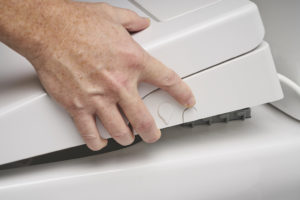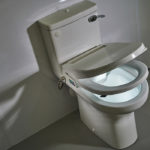Often taken for granted, the seemingly simple act of using a toilet can become challenging for some residents. Stuart Reynolds, Head of Product and Marketing at AKW, discusses a solution to intimate care needs.
Conversations about going to the toilet still seem taboo topics in today’s culture. Yet it is necessary that the subject is addressed by local authority housing and given due care and attention as part of a holistic assessment. For this seemingly simple part of daily life can actually be highly complicated and debilitating for many residents living with disabilities or physical challenges.
The recommended fluid intake for adults is at least 1.5 litres a day, or 6-8 glasses and it is typical to use the toilet between four to eight times a day and once a night. However, those that find toileting difficult are prone to limiting the amount of liquids they consume, in order to reduce the number of times they need to use the toilet, particularly when they need assistance and perceive a loss of dignity. Limiting liquid intake in this way however is dangerous, can actually increase the frequency of visits to the toilet and can lead to dehydration, with older people being particularly vulnerable to this.
Going to the toilet might seem intuitive and like second nature to most of us. But when broken down, the seemingly simple process is actually a series of complex activities. For effective toileting an intricate combination of several physical attributes, cognitive skills and level of environmental understanding is needed. (See the the bullet points at the end of the article)
Putting strategies in place to help those who struggle with going to the toilet can not only prevent hospital admissions, it can also help encourage the safe and effective discharge of those who have been in hospital or care and are making the transition to local authority housing. The ultimate goal for any toileting strategy is that it maintains the individual’s dignity and where possible, promotes their ability to use a toilet independently without any additional care.

An all-round solution
Bidets can play an important role in helping those that need it to achieve toileting independence for longer. Using a bidet is seen as a healthier alternative to toilet paper as they provide better personal hygiene. Bathroom hygiene can be very challenging for those with disabilities. Using a bidet as a main toileting strategy can help to prevent a range of different infections and help the less able to avoid contact with bacteria and germs.
Bidets do not require the same complex levels of dexterity or physical ability that is otherwise needed. As such, they can be operated without any additional help for the majority of people with disabilities, helping to promote dignity and keeping individuals independent for longer.
 Your options
Your options
There are three main types of bidet available: freestanding, built-in or two-in-one, and an over-toilet seat attachment. Over time the size of bathrooms generally has become smaller, therefore freestanding models that many typically envisage when thinking of a bidet, have actually become less common. Two-in-one toilets and bidets, however, are growing in popularity.
Where the main aim is to promote dignity and independence for longer in the home, the seat-like attachment bidet for existing toilets offers some significant benefits for local authority housing. These types of bidets are typically much cheaper than buying and installing a two-in-one bidet/toilet. The cost and installation of such models can be under £1,000, which means they are classed as minor works and eligible for a local authority Minor Works Grant. The solution is also transferable. So, if there’s a change of residents or the current occupier no longer needs the use of a bidet, it can be removed and used elsewhere. The seat-like attachment overcomes the challenges of fitting an additional bidet into a small bathroom.

What to look for
Seat-attached bidets offer a broad range of functions; here are some tips on what to look for:
- Temperature controlled water: Look for bidets that have instant water heating technology and include a range of temperature controls, so that the individual can alter the setting to suit their specific requirements.
- Spray control: As everyone is unique, ensure the bidet has an adjustable spray nozzle, so that spray intensity can be altered and that the type of spray can be changed to suit user comfort and cleaning requirements.
- Dryer setting: Select a bidet that offers a range of drying temperatures and speeds, so that the preferences of the individual and their needs can be taken into account.
- Seat sensor: for ultimate safety, look for a bidet that has an integral seat sensor, so that the bidet can only be activated when someone is actually sitting on the seat.
- Self-cleaning: to ensure that the nozzle and surrounding area are hygienic before and after every use, choose a bidet that has a self-cleaning function.
- Quiet operation: to promote the dignity of the user still further, ensure that the bidet has a low noise heater, pump and dryer.
- Remote operation: a remote makes the bidet easy to use for everybody; it removes the need to use the side controls. A remote can also support carer options within the room, whilst maximising dignity.
With a broad range of functions, affordable costs and well-considered designs, seat-attachment bidets such as those from AKW are an ideal toileting choice for many local authority housing residents. As every resident is unique, local authority housing managers should seek advice from an occupational therapist or appropriate healthcare professional to ensure the chosen bidet will meet the resident’s ongoing needs.
Using the toilet is a complex activity that requires:
Physical attributes:
- Fine and gross motor skills
- Balance
- Muscle control
- Sensory capabilities (proprioception)
Cognitive skills:
- Understanding the need to go
- Knowing how to actually use the toilet
- Recognising the toilet and the object required for the task (constancy)
- Understanding the need to be fully clean
- Understanding the need to wash hands afterwards
- Knowing how to sequence the stages of going to the toilet
Environmental understanding:
- Knowing where the toilet is
- Knowing how to physically access it
- Understanding if it allows the person to access and use it









